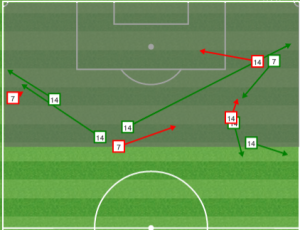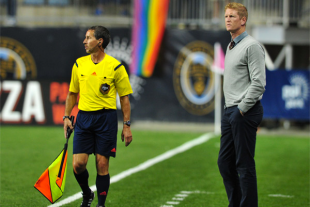Photo: Earl Gardner
The Eastern Conference was bad in 2014. Playoff teams in the east earned 0.12 points less per game compared to playoff teams in the west while scoring 0.16 fewer goals per game. And no, they were not significantly better than the west defensively. This one fact — that the Eastern Conference as a whole was quite bad in 2014 — frames Philadelphia Union’s up-and-down season in the worst light.
And even though Jim Curtin earned at least a point in all but one home game against Eastern Conference opponents in 2014, it remains an area that needs immediate improvement if the Union want to compete for a playoff spot next season.
Home points
When Curtin was announced as the team’s head coach on November 7, he said, “Our home field has to become more of a place when teams come in, they’re intimidated, they don’t want to play there. Right when they get off the bus, they just don’t want to be here. That has to happen; I think that is there already, but closing out games? Too many crazy games in our home field.” And he’s right.
The Union earned 1.54 points per game at home against Eastern Conference competition last year. This is significant because it turns out that earning home points in-conference is a pretty great shortcut to the playoffs even if you are fairly mediocre outside of that category. Even including Kansas City’s outlier of a season that saw them earn only 1 point per game against Eastern Conference opponents at home, playoff teams earned 0.42 more points per game at home against in-conference teams than non-playoff teams. Taking out Kansas City, the difference is even more striking: 2.10 points for playoff teams and only 1.46 for non-playoff teams.
In the Eastern Conference, each team played an average of 12.5 home games against other teams in the east. If the Union had simply earned the average number of points that a playoff team collected in those games, they would have had an extra 8 points in 2014.
Well, sure. Earning extra points in any subset of matches would have helped, right? True. But when looking for those extra points that make the difference between 5th and 6th place — and have no doubt that in a conference featuring well-funded NYCFC and well-run Orlando City the Union will be scrapping for points — the most important points to grab are from home games against in-conference competition.
The importance of home points
One important issue remains unexamined here: How did the Union do in Eastern Conference home games under Jim Curtin? Pretty darn good. About playoff-team average, in fact. And if Philly had played for 90 minutes against Columbus late in the year, Curtin would have boasted a 2.25 home points per game mark, good for second best in the east behind New York.
There are two reasons to focus on in-conference home games as the Union look to improve on their 2014 season. First, across almost every sport, home field advantage appears to be a real phenomenon. In their book Scorecasting, Toby Moscowitz and Jon Wertheim argue that a significant proportion of home field advantage comes from unconscious referee bias.
In other words, referees do not intentionally call games in ways that help the home side, but they end up doing it anyways. A study of nine Bundesliga seasons by Thomas Dohmen found that a major influence on this unconscious referee bias is likely the crowd, with teams that played in stadiums where the crowds were further from the pitch less likely to receive the benefits of unconscious bias. So in a rowdy place — and PPL Park is certainly capable of such a description — a home team should see benefits from the officials that they must take advantage of.
The limits of Curtin’s system
The second reason is more important because it focuses on something Jim Curtin and the Union have to implement through smart personnel and tactical choices. Philadelphia generated an absurd amount of offense through Sebastien Le Toux. The Frenchman scored or assisted 45 percent of the team’s regular season goals under Jim Curtin, and his success is at least partially attributable to a system that played to the strengths of a vertically-inclined winger with endless stamina. However, teams that sat deep stymied Philadelphia’s offense with astounding success. With the Union’s midfield a virtual non-entity offensively, the opposition could safely watch Philly attempt to drive at well-established banks of four with tame impotence while waiting for a chance to break.
The September 13 Red Bulls match is a perfect example. The Union dominated the shots category 13 to 3. But the home side’s only shot on target before the 76th minute was Pedro Ribeiro’s 41st minute goal. And the Union’s only other shot from inside the box before the final fifteen minutes was Andrew Wenger’s attempt 21 seconds into the match.
What makes the Red Bulls match stand out is how is highlights the major issues Philly needs to address tactically in order to earn points in home matches in what will likely be another convoluted Eastern Conference. Under Curtin, the Union break so swiftly that they rarely need to commit more than five players to an attack. This is why, despite the Union pushing to get behind New York all game, the visitors rarely had a chance to counterattack. Philly’s fullbacks stayed deep and the holding duo of Brian Carroll and Amobi Okugo completed all of seven passes from beyond the center circle in the first half.
A way forward
This all serves to say that the home points issue is extremely important and very fixable. But it also means the Union will need to be more flexible than they were in 2014 if they want to make a playoff run next season. Sebastien Le Toux’s brilliance under Curtin will make him a marked man, and teams will be content to sit back at PPL Park and take chances when they come.
Therefore, the Union must become a much more potent possession team at home, one capable of creating chances through sustained pressure. Some coaches have the luxury of deep, talented rosters that allow them to play the same system week after week with only minor adjustments. Others (hey, Dom Kinnear!) exploit inefficiencies to earn more points than expected by dominating on situations outside of the run of play like set pieces.
The Union as they are currently constructed can do neither of these things. But with a solid midfield triangle, they can be more tactically flexible than other teams in the east.
Last season began with excitement about a revamped midfield, but the real fun came when the ball left the middle in a hurry. That system can only take the Union so far.
The Curtin counterattack was no fluke, and the rest of the league knows it. Earning those crucial in-conference points at home demands that the focus returns to the expensive and talented midfield, which can dominate the ball and offer Philadelphia the type of sustained offensive zone pressure that will be required for a playoff run in 2014.



A good read Adam. Thanks for the insights. It seemed rare to me that the Union were able to set up shop around the 18 and control the game- and the times when it happened there were just no fresh ideas… only to push it wide hit a cross (often times not very good crosses) and hope Casey could get on the end of it. From my perspective this is an area that needs huge upgrade.
.
NBA basketball teams resort to the counter attack fast break when they don’t have the personnel to run an effective offense in the half court and this is what I thought about over and over with the Union.
.
Hopefully the addition of Sapong – some players who recognize the importance of late runs in the box and an emerging understanding of the timing of those runs will help the offense. I am not content to offer possession to the other team at home. We have a strong midfield capable of retaining possession I feel – it just comes down to that next step of how to we met out an end product.
a 4-3-3 and 4-2-3-1 easily become a 4-5-1 when holding a lead. We didn’t see this happen a whole lot last year. Nothing wrong with sitting back after scoring your goal. It forces the opposition, who sits back in two banks of four…….to open up. Not a whole lot of tactical flexibility by either coach last season when it came to holding leads, IMHO. Even if you dictate the match at home with a lead, there are going to be times in the match where the opposition is going to try to get on the front foot…… and thats when you make them pay! Ask Chelsea or Manchester City…..they make an art form of it! Agreed, Sapong is a GREAT signing that can make the opposition think twice about pressing a high line.
Scorecasting is a fantastic book. A little bit dry in parts, it had so much interesting information that those dry parts didn’t really matter. Glad to see it getting a plug!
Another fun article. A few points.A team should not commit more than 5 in attack because it is not necessary to do so. If the attacking players are shown how to run,8 defenders will have a hard time stopping them. The key is to construct the attsck so that the attacking fullback is SET UP to penetrate, This involves at least a 5 man attack on either side of the field with efficient movement. Because the MSL is tactically crude, even modestly talented players can be shown by the coach how to become more effective.Curtin has the time to set up the system that will suit his players. He can even play counters all season long and make the playoffs easily. the bar in the east is still pretty low, If he has no say in his roster, then that is another story. Possesion is entirely a matter of organization of the 3 closest players to the ball.
the 3 closest players to the ball, yes, and then the next 3 and then the next 3 and so on. interesting comment- Dr. K.